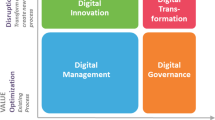Abstract
Universities are facing dynamic environments to which they have to respond by developing new organisational forms often to enhance adaptation. Thereby, governance,management and leadership structures are changing – aiming at increased flexibility,efficiency and effectiveness. This involves new procedures to manage the relationship with the environment, new authority structures within universities, and new ways of resource allocation. Hence, this paper will present empirical results from a cross-national study of adaptive university structures vis-a-vis a changing socioeconomic environment. Based upon that, new organisational forms are introduced which better support and enhance the current trend towards more entrepreneurial universities.
Similar content being viewed by others
REFERENCES
Askling, B., Bauer, M. & Marton, S. (1999). Swedish Universities Towards Self-Regulation. Tertiary Education And Management 5(2), 175-195.
Baldridge, J.V. & Deal, T.E. (1983). The Basics of Change in Educational Organizations. In J.V. Baldridge, T.E. Deal & C. Ingols (eds), The Dynamics of Organizational Change in Education. Berkeley, CA: McCutchan, 1-11.
Bauer, M., Askling, B., Gerard-Marton, S.& Marton, F. (1999). Transforming Universities: Changing Patterns of Governance, Structure and Learning in Swedish Higher Education (Vol. 48). London: Jessica Kingsley.
Berdahl, R. & McConnell, T.R. (1994). Autonomy and Accountability: Some Fundamental Issues. In P.G. Altbach, R.O. Berdahl & P.J. Gumport (eds), Higher Education in American Society. Amherst, NY: Prometheus Books, 55-72.
Cameron, K. (1984). Organizational Adaptation and Higher Education. Journal of Higher Education 55(2), 122-144.
Cameron, K. & Tschirhart, M. (1992). Postindustrial Environments and Organizational Effectiveness in Colleges and Universities. Journal of Higher Education 63(1), 87-108.
Clark, B.R. (1995). Complexity and Differentiation: The Deepening Problem of Integration. In D.D. Dill & B. Sporn (eds), Emerging Patterns of Social Demand and University Reform: Through a Glass Darkly. Oxford: Pergamon, 159-169.
Clark, B.R. (1998a). Creating Entrepreneurial Universities: Organizational Pathways of Transformation. Oxford: Pergamon.
Clark, B.R. (1998b). The Entrepreneurial University: Demand and Response. Tertiary Education and Management 4(1), 5-16.
Cohen, M.D. & March, J.G. (1974). Leadership and Ambiguity: The American College President (2nd ed.). Boston: Harvard Business School Press.
Conrad, C.F. (1978). A Grounded Theory of Academic Change. Sociology of Education 51, 101-112.
Conrad, C.F. (1982). Grounded Theory: An Alternative Approach to Research in Higher Education. The Review of Higher Education 5(4), 259-269.
Dill, D.D. (1994). Rethinking the Planning Process. Planning for Higher Education 22(2), 8-13.
Dill, D.D. & Sporn, B. (1995). University 2001: What Will the University of the Twenty-First Century look Like? In D.D. Dill & B. Sporn (eds), Emerging Patterns of Social Demand and University Reform: Through a Glass Darkly. Oxford: Pergamon, 212-236.
Gumport, P.J. & Sporn, B. (1999). Institutional Adaptation: Demands for Management Reform and University Administration. In J. Smart (ed.), Higher Education: Handbook of Theory and Research (Vol. XIV). New York: Agathon.
Keller, G. (1983). Shaping an Academic Strategy. In G. Keller (ed.), Academic Strategy: The Management Revolution in American Higher Education. Baltimore: The Johns Hopkins University Press, 140-163.
Peterson, M.W. (1995). Images of University Structure, Governance, and Leadership: Adaptive Strategies for the New Environment. In D.D. Dill & B. Sporn (eds), Emerging Patterns of Social Demand and University Reform: Through a Glass Darkly. Oxford: Pergamon, 140-158.
Peterson, M.W. & Dill, D.D. (1997). Understanding the Competitive Environment of the Postsecondary Knowledge Industry. In M.W. Peterson, D.D. Dill & L.A. Mets (eds), Planning and Management for a Changing Environment: A Handbook on Redesigning Postsecondary Institutions. San Francisco: Jossey-Bass, 3-29.
Peterson, M.W. & Mets, L.A. (1987). An Evolutionary Perspective on Academic Governance, Management, and Leadership. In M.W. Peterson & L.A. Mets (eds), Key Resources on Higher Education Governance, Management, and Leadership. San Francisco: Jossey-Bass, 1-20.
Peterson, M.W. & Spencer, M.G. (1990). Understanding Academic Culture and Climate. In W.G. Tierney (ed), Assessing Academic Climates and Cultures (68th ed.). San Francisco: Jossey-Bass, 3-18.
Rhoades, G. (1995). Rethinking Restructuring Universities. Journal of Higher Education Management 10(2), 17-30.
Salancik, G.R. & Pfeffer, J. (1974). The Bases and Use of Power in Organizational Decision Making: The Case of a University. Administrative Science Quarterly 19, 453-473.
Skodvin, O.-J. (1999). Mergers in Higher Education — Success or Failure? Tertiary Education and Management 5(1), 65-80.
Slaughter, S. & Leslie, L.L. (1997). Academic Capitalism: Politics, Policies, and the Entrepreneurial University. Baltimore: The Johns Hopkins University Press.
Sporn, B. (1996). Managing University Culture: An Analysis of the Relationship between Institutional Culture and Management Approaches. Higher Education 32, 41-61.
Sporn, B. (1999a). Adaptive University Structures: An Analysis of Adaptation to Socioeconomic Environments of US and European Universities. London: Jessica Kingsley.
Sporn, B. (1999b). Current Issues and Future Priorities for European Higher Education Systems. In P.G. Altbach & P.M. Peterson (eds), Higher Education in the 21st Century: Global Challenges and National Responses. MD: Institute of International Education, 67-77.
Sporn, B. (1999c). Towards More Adaptive Universities: Trends of Institutional Reform in Europe. Higher Education in Europe XXIV(1), 23-34.
Williams, G.L. (1995). The “Marketization” of Higher Education: Reforms and Potential Reforms in Higher Education Finance. In D.D. Dill & B. Sporn (eds), Emerging Patterns of Social Demand and University Reform: Through a Glass Darkly. Oxford: Pergamon, 170-193.
Yin, R.K. (1994). Case Study Research: Design and Methods. London: Sage.
Author information
Authors and Affiliations
Rights and permissions
About this article
Cite this article
Sporn, B. Building Adaptive Universities: Emerging Organisational Forms Based on Experiences of European and US Universities. Tertiary Education and Management 7, 121–134 (2001). https://doi.org/10.1023/A:1011346201972
Issue Date:
DOI: https://doi.org/10.1023/A:1011346201972




